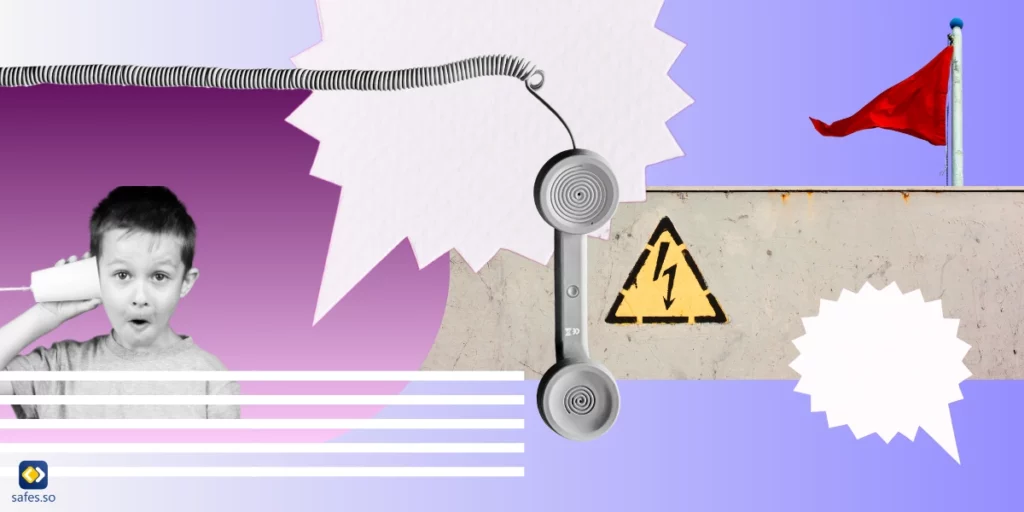Video games have exploded in popularity among kids and teens, with one in four US teens playing video games daily according to Pew Research Center. But amid the bright colors and thrilling missions (and besides games that are inappropriate for kids) lurk online gaming scams that could spell disaster for unsuspecting players. Parents need to understand the risks associated with gaming to help their kids stay safe.
While gaming is fun, offering chances to connect and learn, scammers have also recognized the potential. They’re targeting young gamers, exploiting their excitement and curiosity. These sneaky tactics can lead to lost money, stolen identities, or even worse consequences — and they’re becoming alarmingly common.
Online gaming scams are getting more sophisticated. They blend into the gaming experience so seamlessly that even adults can find them hard to spot. For this reason, parents need to get informed and take the lead in keeping their children safe from these virtual threats.
What Are Gaming Scams?
Gaming scams are deceptive schemes that exploit players, often for financial gain or to obtain personal information. They target everyone, but children are particularly vulnerable. These scams come in various forms — fake giveaways, malware, phishing — each designed to deceive and take advantage of players’ enthusiasm and trust.
The evolution of gaming scams has been swift, keeping pace with the gaming industry’s growth. Scammers know how to exploit excitement around new game features or limited-edition items. The landscape is continuously changing, which means parents and players need to stay vigilant and educated about the latest tactics.
Awareness is the first defense against these threats. For parents, understanding how gaming scams work and how scammers trick young players is crucial in protecting against potential harm. So let’s look deeper into this issue and get prepared for what lies ahead.

The 10 Alarming Gaming Scams
Gamers face a myriad of scams in their virtual adventures, and while gaming can be great fun, parents and players must be aware of the dangers to stay safe. Below, we explore ten of the most concerning scams threatening young players today.
1. Phishing Scams
Scammers often use instant gaming scam tactics, sending deceptive emails or messages that appear legitimate but are designed to steal login credentials. Players might receive links that seem like they come from a trusted game developer but lead to a site set up for capturing their usernames and passwords.
These scams can take many forms, including fake customer support interactions or notifications that “your account will be banned” unless you take immediate action. The goal is to generate urgency and trick players into revealing sensitive information without a second thought.
2. Fake In-Game Purchases
A classic trick involves fake in-game purchases, where scammers set up bogus websites promising special weapons or exclusive skins. These sites lure young players with claims of amazing deals, but once payment is made, nothing is delivered. These fake online game stores also harvest financial information, which can lead to even bigger issues down the line.
It’s essential to purchase items only through official game stores. Children, in particular, may not understand the difference between a legitimate and a fraudulent source. Therefore, parental oversight is critical.
3. Malware in Game Mods
PC gaming scams often involve seemingly harmless game mods. Mods can be an exciting way to enhance gameplay, but scammers have learned how to inject malicious software into them. Players download these mods, thinking they’re adding cool features, only to find their devices infected with viruses or spyware.
Once installed, these malicious mods can steal data, track browsing habits, or even compromise entire systems. Players should stick to trusted modding communities and avoid downloading anything from unofficial websites.
4. Virtual Currency Frauds
Virtual currency frauds target players looking to grab in-game money for cheaper prices. Scammers set up unofficial websites selling discounted virtual coins, gems, or credits. Players think they’re getting a deal but end up paying for worthless, counterfeit currencies.
Not only do they lose money, but sharing payment information on such sites also puts them at risk for further financial exploitation. Always remind your child that if a deal sounds too good to be true, it probably is. Staying within official game platforms is the safest way to purchase virtual currency.
5. Account Takeovers
Account takeovers occur when hackers gain access to gaming accounts to steal valuable in-game assets or personal information. These takeovers often start with a phishing link that appears legitimate but collects a player’s login credentials.
Once they have access, hackers might sell rare items on black markets or use personal information for further scams. Players should enable two-factor authentication to help prevent these takeovers. Parents should work with their children to set up these security features and explain their importance.

6. Fake Giveaways and Contests
Many young gamers fall for fake giveaways that promise free items, rare skins, or exclusive access. Scammers use enticing social media posts to invite players to click a link or share personal information for a chance to win. These contests often look very convincing.
Instead of winning fabulous prizes, victims often end up clicking on malicious links that install malware or capture their data. Teaching children about the risk of “no-cost” offers is a simple but effective way to reduce these risks. Parents should remind their children that real prizes rarely come without some form of legitimate validation.
7. Loot Boxes and Microtransactions
Loot boxes may seem innocent, but they’re designed to exploit the thrill of chance. Players spend real money without any guarantee of getting something they want. This form of microtransaction is especially risky for younger players, who might not recognize the gambling-like nature of these purchases.
The randomness involved keeps kids spending repeatedly in hopes of finally obtaining the item they desire. Parents should consider disabling these purchases or having a conversation about the dangers of impulsive spending and video game addiction.
8. Predatory Subscription Models
Some games employ predatory subscription models that trick players into recurring payments. They offer a trial period, only to automatically convert it into a costly monthly subscription. These subscriptions can be hard to cancel and lead to unexpected expenses that quickly add up.
Parents should keep an eye out for unfamiliar charges on their payment methods and discuss with their children the difference between one-time purchases and subscriptions. Explaining how these charges work can help children make informed decisions and avoid unexpected bills.
9. Social Engineering and Grooming
Online games with chat features open doors for social engineering, where scammers use manipulation tactics to earn trust. These scammers might pretend to be friends and gradually ask for personal information or money. The friendliness of scammers makes it easy for children to fall victim.
Grooming is especially dangerous, as predators build relationships with young players to exploit them emotionally or financially. Monitoring chat interactions and encouraging your child to avoid sharing personal information are essential preventive measures. Regular conversations about the potential dangers of online friends can also help keep kids safe.
10. Unauthorized Third-Party Sites
Unauthorized third-party sites offer cheats, hacks, or shortcuts that promise an advantage in a game. Not only do these sites risk infecting devices with malware, but using cheats can also lead to a player’s account getting permanently banned. These consequences are often severe and may include losing access to a favorite game entirely.
These sites prey on players who want to skip the grind, but the risks far outweigh the rewards. A conversation about the dangers of “shortcuts” can go a long way in keeping children safe. Emphasizing that skill development is part of the gaming experience can also help reduce the temptation of cheats.
How to Protect Your Child from Gaming Scams
Parents can these preventative measures to protect their children from gaming scams:
- Educate Your Child: Start with open conversations about gaming scams. Explain the tactics used by scammers and why it’s important to be cautious. Knowledge is the strongest shield they can carry, and understanding these risks empowers them to make safer choices.
- Monitor Gaming Activity: Take an interest in the games your child plays. Watching their gaming activity can help you spot early warning signs of malicious behavior or scams before any damage occurs. It also creates opportunities to discuss any unusual interactions that might happen.
- Use Parental Controls: Built-in parental controls and parental control apps can be incredibly effective. Limit in-game purchases, restrict access to unknown players, and ensure your child’s account is protected. Taking full advantage of these tools can significantly minimize the risk of falling victim to gaming scams.
- Set Spending Limits: Establish strict boundaries for in-game spending. If payments are required, consider making them yourself after evaluating the legitimacy. Small costs add up, and limiting access helps avoid accidental purchases. This also provides a valuable lesson on budgeting and the responsible use of money.
- Encourage Critical Thinking: Teach your child to think critically about online offers. Whether it’s a free giveaway or an “amazing deal,” critical thinking helps them recognize what’s real and what’s an attempt to scam. Developing this mindset is invaluable in helping them navigate online spaces safely.
Safes: Safer Gaming
Parental control apps are invaluable in managing gaming habits and interactions. Our app, Safes, offers a comprehensive suite of features that allow parents to set clear limits and monitor activities effectively. These capabilities include real-time activity monitoring, the ability to block specific content, and setting screen time schedules tailored to each child’s needs. With Safes, parents can also receive alerts for any suspicious activity.
Interested? Try our free trial and see how it can help! Available on both iOS and Android, Safes provides peace of mind for parents navigating the digital landscape. The app also includes geolocation features, allowing parents to track their children’s whereabouts if needed. Our goal is to make parenting in the digital age simpler and safer, giving families the tools they need to thrive.
Conclusion
Gaming scams may be a real and growing concern, but staying informed helps reduce the risk significantly. Open communication is the cornerstone of keeping your child safe in the online gaming world. Keeping the dialogue open makes it easier for children to share any suspicious activities they encounter.
Encourage curiosity while educating them about the risks they might face. Awareness and understanding form a shield against potential threats. The more children understand the tactics used by scammers, the better equipped they are to avoid falling into traps.
With knowledge, practical tools, and proactive measures, parents can help children enjoy the thrilling world of gaming while minimizing risks. Together, we can ensure that the joy of gaming remains pure and free from danger, allowing children to explore virtual worlds safely.




